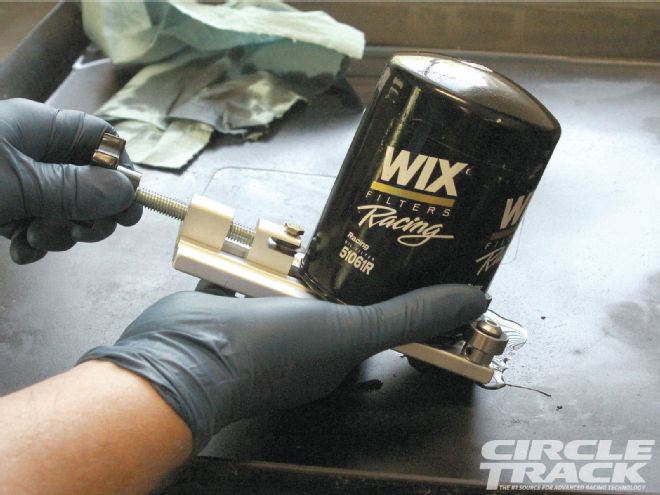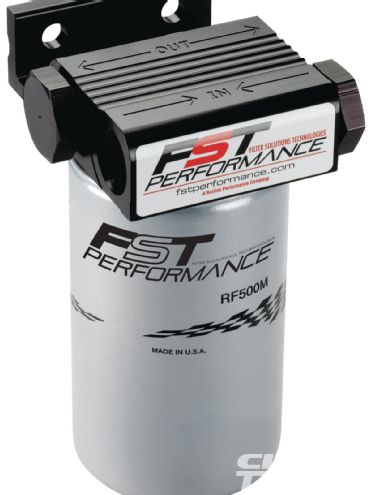
There are lots of things about stock car racing that are sexy or cool--but filters definitely aren't on that list.
Still, like a driver's license, running water and clean underwear, filters for your race car are something you can't do without--even if you don't give them much thought. Just swap 'em out every so often and get on with your life, right?
Well, maybe, but there are ways you can improve your racing program by taking a close look at how well your filters are working. Your oil filter can even give you vital clues to your engine's health and help you spot problems before they lead to engine failure.
 FST Performance’s fuel filter is a revolutionary design that uses a cellulose filter that can filter gasoline or other fuels down to 3 microns while allowing 350 gallons per hour of flow. The replaceable spin-on filter makes it look a lot like a remotely mounted oil filter, but its large capacity allows the filter to have an astounding 579 square inches of surface area.
FST Performance’s fuel filter is a revolutionary design that uses a cellulose filter that can filter gasoline or other fuels down to 3 microns while allowing 350 gallons per hour of flow. The replaceable spin-on filter makes it look a lot like a remotely mounted oil filter, but its large capacity allows the filter to have an astounding 579 square inches of surface area.
The solution Dorton found was a new type of fuel filter from FST Performance. This filter looks a heck of a lot like a remote oil filter system but it's actually designed specifically around the requirements of filtering gasoline. For its spin-on filter systems, FST uses an oil filter style steel canister because they are effective, durable and incorporating the same design saves costs. But the interior of the can is packed with a special cellulose filter (you might call it "paper") that can filter very fine particles while still allowing lots of flow.
"For years when it came to fuel, especially in the performance industry when running a carburetor, everything was all about the amount the filter could flow," explains FST owner Rick Rolling. "Get as much fuel through the filter as quickly as possible. Actually filtering the fuel was secondary. So the standard with the wire screen media they've been using is around 40 microns. Anything smaller than that gets right through."
Forty microns--or anything labeled as a "micron" for that matter--seems pretty small, but Rollins says in the real world it's unnecessarily large. "Now that the Cup guys have switched to fuel injection, if a 39-micron particle gets past the filter and lodges in the injector, that injector is dead. So we've developed the cellulose filter, and our biggest filter can filter down to 3 microns and flows over 350 gallons per hour which will service over 2,000 horsepower."
FST is able to achieve such incredible filtering and flow numbers because the spin-on design allows for acres of surface area for the filtering media. Where most fuel filters have around 60 square inches of surface area at most, Rollins' design has 579 square inches--nearly 10 times the surface area.
For NASCAR approval, Rollins has also developed an inline filter that looks like a conventional fuel filter. It also utilizes the cellulose filter media but the smaller canister means the filter media's surface area is reduced--but still an outstanding 122 square inches. To keep the flow up around the 350 gallons per hour rate, this media filters down to four microns.
The FST filters are also disposable. After purchasing the billet aluminum remote mounts, replacement spin-on filters sell for 24 bucks or less. Rollins says he has a Dirt Late Model racer using his smallest filter, which sells for $16.99 and racing well with it. The inline filter uses replacement units that sell for $39. "I've had racers tell me that it's more economical to use the screen filters because they can clean and reuse them," Rollins says. "But then I ask them what they are cleaning them with, and how clean is that, and they tend to get real quiet. If you are cleaning your screen filter in the parts washer, it's probably coming out with more trash in it than when you started. By using a replacement filter you know you are getting the best filtering possible every time you spin on a fresh filter."
Another unique factor with the FST filters is that they are also effective at filtering water. A screen filter poses to obstacle to water contamination in race fuel, but FST's cellulose media blocks it. Also, unlike a real paper filter, the cellulose material doesn't absorb the water. Instead, Rollins says his filters are all designed with a "quiet area" where the water can collect. In the spin-on filters, it's in the bottom of the can. For the inline filter, Rollins designed a canister that's 8 inches long and a filter that's just 6.5 inches. By mounting the inlet side of the filter slightly lower than the outlet side, any water that's separated out of the fuel by the filter media settles below the filter and allows the fuel to pass safely by.
This is probably the most important factor for Saturday night racers. Newer fuels containing a percentage of ethanol are becoming more and more common at racetracks, and ethanol is known to attract water. Rollins says you don't have to purchase fuel that is already contaminated by water--simply allowing it to sit for any length of time will mean that it draws some amount of water. Plus, in-ground fuel tanks at racetracks are notorious for contaminating fuels. The more of that stuff you can keep out of your carburetor, the better off you will be.
High-end race engines with dry sump oiling systems utilize a screen filter, commonly referred to as an "oberg filter," which can be easily cleaned and inspected. Simply open the top of the oil tank, remove the oberg screen and take a look to see what is trapped in the mesh.
But things get a little trickier with a wet oiling system using a conventional oil filter. These filters are sealed and not meant to be broken open, but that doesn't mean you can't do exactly that. And the information you can glean from a canister oil filter is just as valuable as what you can learn inspecting an oberg.
Of course, the trick is getting a used oil filter open so you can take a look at what it has filtered out of the oil. The sealed steel casing is designed to be pretty tough in order to prevent leaks, but that means it's also a pretty tough nut to crack. You can get one open with tin snips or a saw, but the result is just about guaranteed to be a huge mess.
Instead, use a cutter designed specifically for splitting open an oil filter like the one we sourced from Powerhouse Products. There is no way to avoid making at least a bit of a mess, but the Powerhouse oil filter cutter helps minimize it, and the device also greatly reduces the chances of you cutting up anything (like your hands) besides the oil filter.
You should definitely consider cutting open and "reading" your oil filter for clues any time you are breaking in a new engine or notice that your old engine isn't running quite right or seems to be down on power. If your engine is broken in and running well, cutting up every filter probably isn't necessary, but continuing the practice at least occasionally is still a good idea to help you catch small problems before they become big ones.
Once you have the filter element loose from its protective steel case, you can check to see what it has caught. Small metal shavings can be difficult to see in the oil-soaked filter media, so you need to use a discerning eye. Spread out the folds in the filter material so you can see if anything has been caught deep in the seams.
What you find depends on what is going on with your engine. During the break-in process, having some small amounts of material from all parts of the engine isn't unusual. This is simply the byproduct of the parts mating together. If the engine is built correctly and running well, that should end fairly quickly.
But if you never stop finding metal in your filter--or it begins out of the blue--determining what you've found can be more difficult. One of the easiest tests is to use a magnet to separate the magnetic (or ferrous) metals from the non-magnetic metals. If it sticks to the magnet, that means it is steel, and steel can mean it came from the cylinder liner, lifters, piston rings, or any number of other components. Bits of aluminum usually come from the pistons, but they may also come from aluminum cylinder heads, if you are running them. Titanium--from valves, springs or retainers--is also non-magnetic.
Another test is to rub the material between your fingers. Aluminum is soft and the shavings will bend under the pressure between your fingers. Steel is stiffer and more likely to break, and also not as shiny as aluminum. Titanium, on the other hand, is shiny like aluminum but breaks instead of bending like aluminum.
Small amounts of metal shouldn't usually cause too much concern, but if you suddenly start seeing increased levels of magnetic shavings, it could be a sign that you are losing a cam lobe (if you are running a flat tappet design). Aluminum flakes are usually less of a concern because they are almost always from the piston skirts. If you're running OEM style bearings, aluminum may also come from the bearing surface flaking. High-quality race bearings, however, normally have a copper-colored inner babbitt layer which also makes it easier to spot.
Remember when inspecting your oil or fuel filter to take your time, keep a keen eye on what you're looking at and do a thorough analysis. That way you will be sure to spot any potential problems long before they contribute to a catastrophic failure.